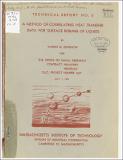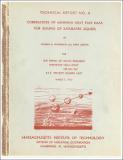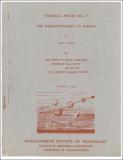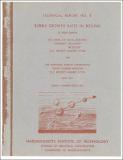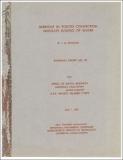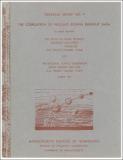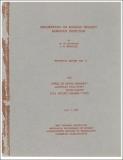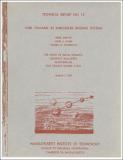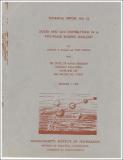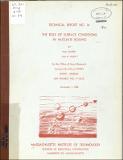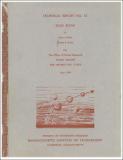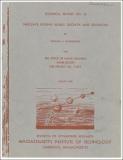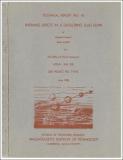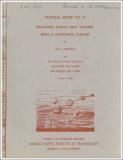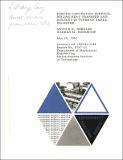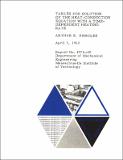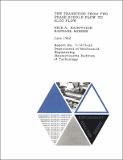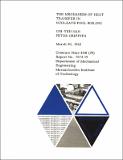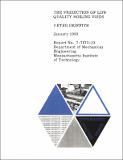Browsing Department of Mechanical Engineering by Issue Date
Now showing items 1-20 of 137
-
Heat transfer and pressure drop data for high heat flux densities to water at high subcritical pressures
(Cambridge, Mass. : M.I.T. Division of Industrial Cooperation, 1951, 1951)Local surface ooeffioients of heat t-ansfer, overall pressure drop data and mean friction factor are presented for heat flamms up to 3.52106 BtuAr ft2 for water flowing in a nickel tabe isder the following conditions: mass ... -
A method of correlating heat transfer data for surface boiling of liquids
(Cambridge, Mass. : M.I.T. Division of Industrial Cooporation, [1951], 1951)A method based an a logical uxplanation of the meani of beat transfer associated with the boiling process is presented for correlating heat transfer data for nucleate boiling of liquids for the case of pool boiling. Tbe ... -
Correlation of maximum heat flux data for boiling of saturated liquids
(Cambridge, Mass. : Massachusetts Institute of Technology, Division of Industrial Cooperation, [1955], 1955) -
The thermodynamics of bubbles
(Cambridge, Mass. : Massachusetts Institute of Technology, Division of Industrial Cooperation, [1956], 1956)This paper outlines those concitions annanded by the laws of thermodynamics for equilibriza betwoen the vapor in a bubble and the surrounding liquid and then employs these concepts with a nucleation theory in an atteapt ... -
Bubble growth rates in boiling
(Cambridge, Mass. : Massachusetts Institute of Technology, Division of Industrial Cooperation, [1956], 1956)The conditions determining the growth rate of a bubble on a surface in boiling are considered and a mathematical model framed in the light of these conditions. The growth rate is then calculated for bubbles growing under ... -
Burnout in forced convection nucleate boiling of water
(Cambridge, Mass. : M.I.T. Heat Transfer Laboratory, [1957], 1957)Data are presented for burnout in forced coivection nucleate boiling of water at pressures above 500 psia. A dimensionless correlation is devised for. the M.I.T. data which is found to be valid for certain recent data ... -
The correlation of nucleate boiling burn-out data
(Cambridge, Mass. : M.I.T. Division of Industrial Cooperation, [1957], 1957)A dimensionless correlation is developed for nucleate boiling buzrnout data including the following ranges of variables. Fluids - Water Bensene n - Heptane n - Pentane Ethanol Pressure - 0.0045 to 0.96 of critical pressure ... -
Description of boiling project burnout detector
(Cambridge, Mass. : M.I.T. Heat Transfer Laboratory, [1957], 1957)Introduction: In order to effectively utilize the high heat flux available through the mechanism of nucleate boiling in forced convection heat transfer, it is of primary importance that the maximum flux or "burnout" ... -
Void volumes in subcooled boiling systems
(Cambridge, Mass. : M.I.T. Division of Industrial Cooperation, [1958], 1958)Introduction: Knowledge of the pressure drop in a channel and the resulting flow redistribution is essential in predicting the performance of a nuclear reactor. The pressure drop in a channel which is experiencing boiling ... -
Liquid and gas distributions in a two-phase boiling analogy
(Cambridge, Mass. : Massachusetts Institute of Technology, Division of Industrial Cooperation, [1958], 1958)This report contains a description of the design and operation of an experimental appats for the analysis of two-phase flows similar to thom occuwring in boiler tubes at low pressures. Velocity and denuity profiles of ... -
The role of surface conditions in nucleate boiling
(Cambridge, Mass. : Massachusetts Institute of Technology, Division of Industrial Cooperation, [1958], 1958)Nucleation from a single cavity has been stuied indicating that cavity gemtry is aportant in two ways. The mouth diameter determines the superheat nmeded to initiate boiling and its shape determines its stability one boiling ... -
Slug flow
(Cambridge, Mass. : Division of Sponsored Research, Massachusetts Institute of Technology, [1959], 1959)Introduction: When two phases flow concurrently in a pipe, they can distribute themselves in a number of different configurations. The gas could be uniformly dispersed throughout the liquid in the form of small bubbles. ... -
Nucleate boiling bubble growth and departure
(Cambridge, Mass. : Massachusetts Institute of Technology, Division of Industrial Cooperation, [1959], 1959)The vapor bubble formation on the heating surface during pool boiling has been studied experimentally. Experiments were made at the atmospheric pressure 28 psi and 40 psi, using degassed distilled water and ethanol. The ... -
Entrance effects in a developing slug flow
(Cambridge, Mass. : Massachusetts Institute of Technology, Division of Industrial Cooperation, [1960], 1960)The kinetics of a Taylor bubble, as it rises behind a series of other bubbles in a gas-liquid slug flow, have been determined. The rise velocity of a bubble is expressed as a function of separation distance from the bubble ... -
Transition boiling heat transfer from a horizontal surface
(Cambridge, Mass. : Massachusetts Institute of Technology, Division of Industrial Cooperation, [1960], 1960)An experiment, utilising a condensing fluid as the heat source, was performed to determine the heat flux vs. temperature difference curve for transition pool boiling from a horisontal surface. The boiling cure was determined ... -
Forced-convection surface-boiling heat transfer and burnout in tubes of small diameters
(Cambridge, Mass. : M.I.T. Dept. of Mechanical Engineering, [1962], 1962)A basic heat-transfer apparatus was designed and constructed for the study of forced-convection boiling in small channels. The various regions of forced-convection surface boiling were studied experimentally and analytically. ... -
Tables for solution of the heat-conduction equation with a time-dependent heating rate
(Cambridge, Mass. : M.I.T. Heat Transfer Laboratory, [1962], 1962)Tables are presented for the solution of the transient onedimensional heat flow in a solid body of constant material properties with the heating rate at one boundary dependent on time. These tables allow convenient and ... -
The transition from two phase bubble flow to slug flow
(Cambridge, Mass. : M.I.T. Division of Sponsored Research, [1962], 1962)The process of transition from bubble to slug flow in a vertical pipe has been studied analytically and experimentally. An equation is presented which gives the agglomeration time as a function of void fraction, channel ... -
The mechanism of heat transfer in nucleate pool boiling
(Cambridge, Mass. : M.I.T. Division of Sponsored Research, [1962], 1962)A criterion is developed for bubble initiation from a gas filled cavity on a surface in contact with a superheated layer of liquid. It is found that the temperature of bubble initiation on a given surface is a function of ... -
The prediction of low quality boiling voids
(Cambridge, Mass. : M.I.T. Division of Sponsored Research, [1963], 1963)Slug flow theory is used to predict the density in heated channels of various shapes. In order to make this calculation possible, measurements are made of the bubble rise velocity in annuli, tube bundles, and channels. It ...


